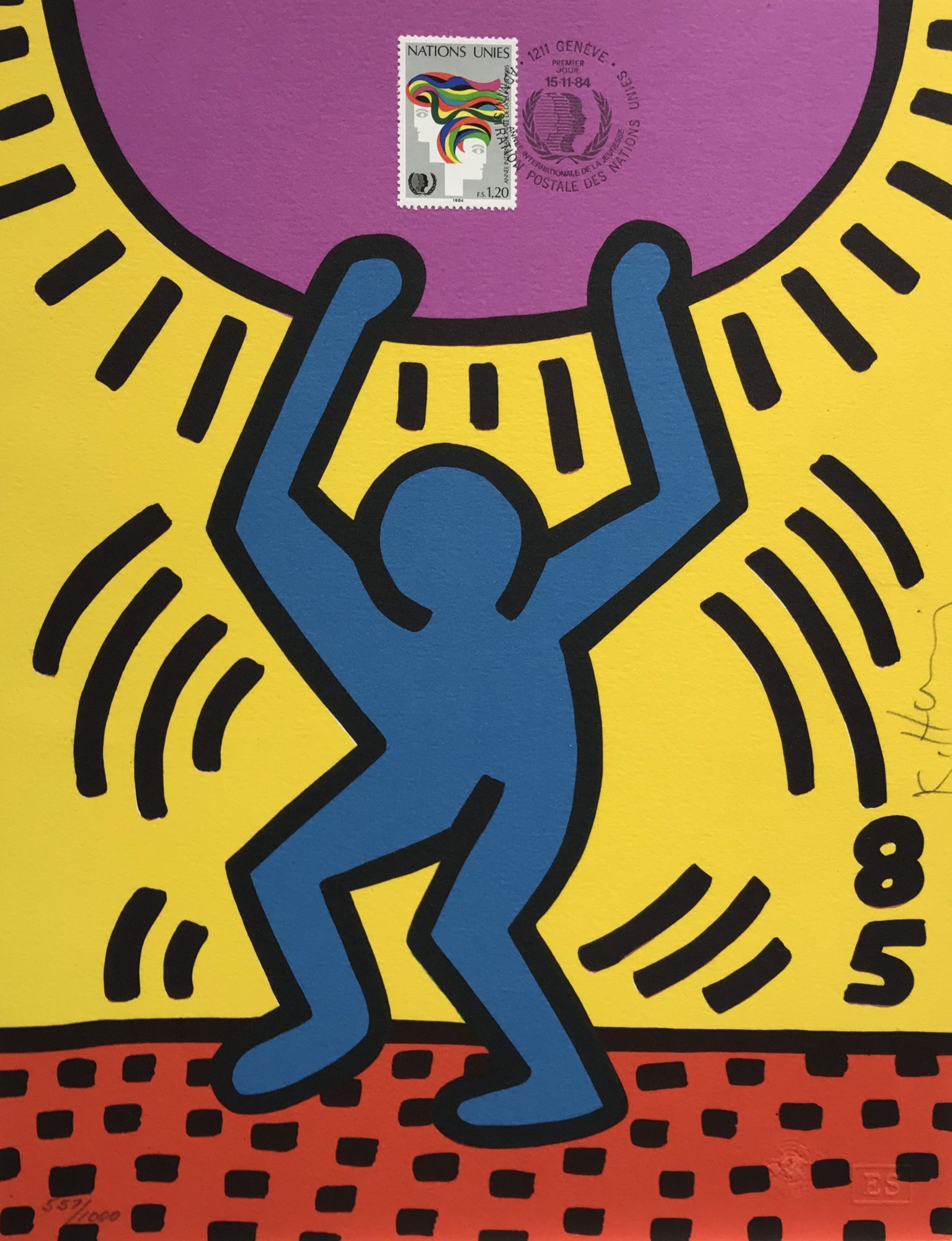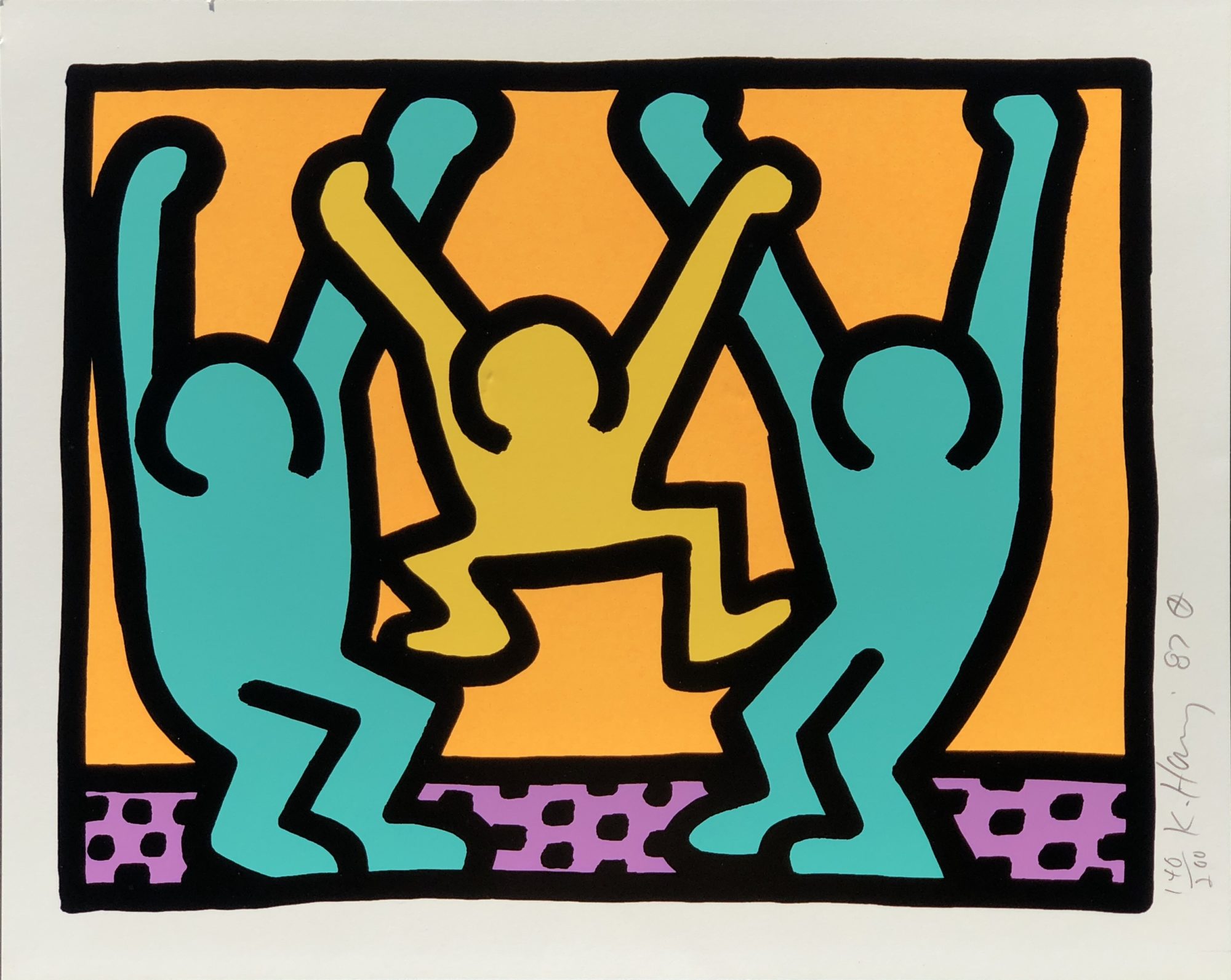Keith Haring was an American Pop Artist born on May 4, 1958, in Reading, Pennsylvania, and was raised in nearby Kutztown, Pennsylvania. Keith Haring developed a love for art at a very early age, learning basic cartooning skills from his father and from the pop-culture around him, including Dr. Seuss and Walt Disney.
After graduating from high school in 1976, Keith Haring enrolled in the Ivy School of Professional Art in Pittsburgh, a commercial art school. Keith Haring soon realized that he had little interest in becoming a commercial graphic artist and after two semesters Haring dropped out. While in Pittsburgh, he continued to work on his art, and in 1978 Keith Haring had a solo exhibition of his art at the Pittsburgh Arts and Crafts Center.
At the age of 19, Haring, who was openly gay, moved to New York City and enrolled in the School of Visual Art (SVA). In New York, he found a thriving alternative art community that was developing outside the gallery and museum system, in the downtown streets, subways, small clubs and former dance halls. Keith Haring befriended fellow artists Kenny Scharf and Jean-Michel Basquiat, as well as the musicians, performance artists and graffiti artists within the burgeoning art community.
Keith Haring was inspired by the art of Pierre Alechinsky, Jean Dubuffet, Paul Klee, William Burroughs, and specifically Robert Henri’s manifesto ‘The Art Spirit’, which asserted the fundamental independence of the artist. Utilizing his own youthful impulses, Kieth Haring developed a singular style of graphic expression based on the dominance of the line. Haring was also drawn to the public and participatory nature of the art of Christo and was equally influenced by Andy Warhol’s unique fusion of art and life. Keith Haring was determined to devote his artistic career to creating a truly public art.
As an SVA student, Keith Haring experimented with performance, video, installation, and collage, while always maintaining a strong commitment to drawing. In 1980, Keith Haring found a highly effective medium that allowed him to communicate with the wider audience he desired when Haring noticed the unused advertising panels covered with matte black paper in the New York City subway stations. Keith Haring began to create graffiti art in white chalk on these panels throughout the subway system. Between 1980 and 1985, Keith Harring produced hundreds of these public drawings in rapid rhythmic lines, sometimes creating as many as forty “subway drawings” in one day. This seamless flow of images became familiar to commuters, who often would stop to engage the Haring when they encountered him at work. The subway became, as Keith Haring said, a “laboratory” for working out ideas and experimenting with simple lines. Around this time, The Radiant baby became Haring’s symbol.
Between 1980 and 1989, Keith Haring achieved international recognition and participated in several art exhibitions. Haring’s first solo exhibition in New York was held at the Westbeth Painters Space in 1981. In 1982, Keith Haring made his Soho gallery debut with an acclaimed one-man show at the Tony Shafrazi Gallery. Haring also participated in renowned international survey exhibitions such as Documenta 7 in Kassel; the Sao Paulo Biennial; the Paris Biennial and the Whitney Biennial. Keith Haring completed numerous public projects in the first half of the 80’s including animation for the electronic billboard in Times Square; designing sets and theatrical backdrops; developing designs for Swatch Watches; an Absolut Vodka advertising campaign; and creating a mural on the Berlin Wall.
In 1986, Keith Haring opened the Pop Shop, a retail store in Soho selling T-shirts, toys, posters, buttons, and magnets bearing Haring’s iconic images. Haring considered the shop to be an extension of his work and painted the entire interior of the store in an abstract black on a white mural, creating a striking and unique retail environment. The shop was intended to allow people greater access to Haring’s art, readily available on products at a low cost. The shop received criticism from many in the art world, however, Keith Haring remained committed to making his art available to as wide an audience as possible, and received strong support for his project from friends, fans, and mentors including Andy Warhol.
Throughout Haring’s career, Keith Haring devoted much of his time to public artworks, which often carried social messages. Keith Haring produced more than 50 public artworks between 1982 and 1989, in dozens of cities around the world, many of which were created for charities, hospitals, children’s day care centers and orphanages. Keith Haring also held art workshops for children in schools and museums in New York, Amsterdam, London, Tokyo and Bordeaux, and produced imagery for literacy programs, environmental movements, human rights awareness and other public service campaigns.
Keith Haring was diagnosed with AIDS in 1988. In 1989, he established the Keith Haring Foundation, a foundation dedicated to providing funding and imagery to AIDS organizations and children’s programs, and to expand the audience for Haring’s art through exhibitions, publications and the licensing of his images. Keith Haring enlisted his imagery during the last years of his life to speak about his own illness and generate activism and awareness about AIDS.
During a brief but intense career that spanned the 1980s, Haring’s art was featured in over 100 solo and group art exhibitions. In 1986 alone, Keith Haring was the subject of more than 40 newspaper and magazine articles. By expressing universal concepts of birth, death, love, sex, and war, using a primacy of line and directness of message, Keith Haring was able to attract a wide audience and assure the accessibility and staying power of his imagery, which has become a universally recognized visual language of the 20th century.
Keith Haring died of AIDS-related complications at the age of 31 on February 16, 1990. A memorial service was held on May 4, 1990, at the Cathedral of St. John the Divine in New York City, with over 1,000 people in attendance. Since his death, Keith Haring has been the subject of several international retrospectives. The work of Keith Haring can be seen today in the exhibitions and collections of major museums around the world.
“I don’t think art is propaganda; it should be something that liberates the soul, provokes the imagination and encourages people to go further. It celebrates humanity instead of manipulating it.” – Keith Haring
Select Museum Collections:
Art Institute of Chicago, Chicago
Museum of Modern Art, New York
Andy Warhol Museum, Pittsburgh
Whitney Museum of American Art, New York
National Gallery of Canada, Ottawa
Centre Georges Pompidou, Paris
Museum of Contemporary Art, Jerusalem
Stedelijk Museum, Amsterdam
The Museum of Art, Kochi, Japan





